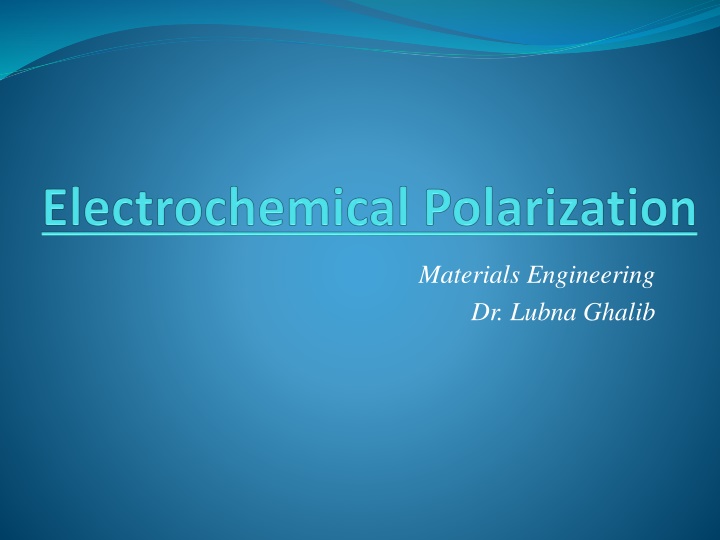
Electrochemical Polarization in Materials Engineering
Learn about electrochemical polarization in materials engineering, including activation and concentration polarization, anodic and cathodic polarization, and examples of polarization effects on electrode potential. Explore the factors that limit electrochemical reactions and how polarization plays a role in influencing the flow of current.
Download Presentation

Please find below an Image/Link to download the presentation.
The content on the website is provided AS IS for your information and personal use only. It may not be sold, licensed, or shared on other websites without obtaining consent from the author. If you encounter any issues during the download, it is possible that the publisher has removed the file from their server.
You are allowed to download the files provided on this website for personal or commercial use, subject to the condition that they are used lawfully. All files are the property of their respective owners.
The content on the website is provided AS IS for your information and personal use only. It may not be sold, licensed, or shared on other websites without obtaining consent from the author.
E N D
Presentation Transcript
Materials Engineering Dr. Lubna Ghalib
Electrochemical Polarization: .Electrochemical polarization (usually referred to simply as polarization ) is the change in electrode potential due to the flow of current. The rate of an electro- chemical reaction is limited by various physical and chemical factors. Hence an electro-chemical reaction is said to be polarized or retarded by these environmental factors. There are two types of polarization: 1) Activation Polarization: is polarization caused by a slow electrode reaction. 2) Concentration Polarization: is polarization caused by concentration changes in reactants or products near an electrode surface.
Anodic and Cathodic polarization: .Either an anode or a cathode can be polarized: Anodic polarization is the displacement of the electrode potential in the positive direction so that the electrode acts more anodic. Cathodic polarization is the displacement of the electrode potential in the negative direction so that the electrode acts more cathodic. These processes are represented schematically in Figure 8
Example 3: .Consider the hydrogen evolution reaction occurring at a metal surface. First: Hydrogen atoms are produced by the reduction reaction 2H+ +2 e- 2Hads. This process of activation polarization involves a slow step in the electrode reaction. Suppose that electrons are supplied to the metal electrode faster than they can react to form H atoms, as represented in the Figure 9. Then the concentration of electrons is increased at the metal side of the interface. The result is that the electrode potential E becomes more negative, due to activation polarization. 2Hads. H2
Example 3: .Suppose instead that there are concentration effects near the electrode surface for hydrogen reduction reaction. If reactant hydrogen H+ are slow to diffuse to the electrode surface, as illustrated in Figure 10, then electrons again can accumulate at the metal side of the interface. The result is that the electrode potential E again becomes more negative, but this time due to concentration polarization
Example 3: .Second: Suppose that the oxidation of Fe atoms to Fe2+ ions is slow. Then electrons exit the electrode faster than Fe atoms leave the metal matrix, as illustrated in Figure 11. This means that the electron concentration is decreased at the metal side of the interface. The electrode potential E thus becomes more positive due to activation polarization.
Example 3: .Suppose next that the products of the anodic reaction, Fe2+ ions are slow to diffuse away from the metal surface, as represented in Figure 12. The surface becomes more positively changed due to the accumulation of Fe2+ ions. The electrode potential E again becomes more positive, but this time due to concentration polarization.















